Christopher Booker has argued (1 July 2017, also here) that our EU membership has been a contributory factor to the Grenfell Tower disaster. He claims that a Commons committee, set up to investigate the fire risks of cladding on multi-storey blocks, had wanted to replace the European standard EN 13501-1 with the British standard BS 8414, but had been unable to, because of the former standard’s mandatory status in the EU:
Again, as his conclusion, he argues that:
if only full compliance with the BS 8414 standard could have been made mandatory … that fearful conflagration would never have happened.
This is putting a great deal of responsibility for the Grenfell disaster on our EU membership, an assignment of blame which I believe is entirely misplaced.
construction products and buildings
My understanding is that fire safety aspects of building regulations are a national competence and that we are free to make whatever regulations we see fit to preserve our own safety.
Booker, on the other hand, in an earlier article, claims that making what he calls ‘construction regulations’, ‘including those relating to fire risk’, is an exclusive competence of the EU. Britain cannot make its own without Brussels permission, he writes:
The term ‘construction regulations’ is ambiguous and, in my opinion, this is where Booker goes wrong. Construction products are one thing, and buildings are another. Products, in general, are transported from one place to another, and so naturally fall into the sphere of the internal market in a way which buildings, which generally stay put, do not. The Construction Products Regulation allows a manufacturer to market their product throughout the EU (and EEA) without having to tailor it to meet individual national product regulations. No doubt there could be advantages for the larger house builders in having the same housing regulations throughout the EU, so that they could build a standard house anywhere, but the case for harmonisation is much less strong, I think. Moreover, it may be that differences in building regulations are related to a diversity of building methods and concomitant architectural styles that are considered worth preserving as aspects of national culture and particularity. Whatever the reason, it seems that a distinction has been made between construction products and buildings, with one regulated by the EU and the other not.
A Commission Report, COM(2016) 445, confirms that while the EU deals with ‘single market access rules’, Member States: 1
are responsible for safety, environmental and energy requirements applicable to construction works
But buildings, which are nationally regulated, are built from construction products, which are EU-regulated. As a result the European standards and EU Directives and Regulations do certainly have an impact on the national building regulations. An example, chosen simply as the first case I found of a European standard in Approved Document (AD) B, serves to illustrate some features of how the two spheres interact with one another. It comes in the first section, ‘Fire alarm and fire detection systems’, of AD B, Vol. 2 (‘Fire Safety, Buildings other than Dwellinghouses’). Paragraph 1.4 provides that all new flats should be provided with a fire alarm system in accordance with a British Code of Practice for such systems:
The Code of Practice, among many other matters, makes recommendations as to what grade of system should be installed in which category of dwelling (extract only):
The choice of which grade of alarm should be fitted in which category of home is I believe entirely within the control of the national government. The next paragraph of AD B2 concerns the alarms themselves, a distinction being made between alarms according to whether they are triggered by smoke or heat. There is a European harmonised standard for smoke alarms, but not for heat alarms:
EN 14604:2005 is a European standard for smoke alarms. All national members of the standardisation agency CEN are obliged to implement new standards as national standards, normally without change. 2 Thus in this case the British Standard is BS EN 14604:2005:
while BS 5446-2:2003 is a UK standard for heat alarms:
Part 1 of the BS 5446 series had been a specification for smoke alarms:
but it was withdrawn when the European standard for smoke alarms was introduced, as stated in the National Foreword to BS EN 14604:2005:
This example illustrates several points:
- The requirements for the buildings themselves are in general determined nationally.
- Requirements for products used within the buildings may make reference to European harmonised standards where they exist.
- Where there is no European standard for a product, reference may be made to a national product standard.
- National standards are withdrawn when a European standard is introduced for that product type.
The one exception to point 1 that I am aware of concerns energy use in buildings.
Energy Performance of Buildings Directive
Booker has argued (1 July) that the EU’s Energy Performance in Buildings Directive (EPBD, 2002/91/EC) had a role to play in the Grenfell fire. At a moment when improved fire safety regulations for cladding could have been brought in, John Prescott’s officials were ‘concerned only with new regulations to improve insulation’ required under the EPBD:
Booker’s articles draw extensively on research done by Richard North, with whom he co-authored several books. 3 North says (18 June) that the 2010 recast Directive (2010/31/EU) had ‘considerable relevance’ to the fire, because its ‘energy efficiency requirements’ contain a requirement for renovations to be accompanied by extra insulation:
It may be true to say – and I am at any rate willing to accept for sake of argument – that the current UK guidance on appropriate energy performance levels for buildings is strongly determined by the EPBD, even if not in a very simple way, since it is through the application of an EU methodology which aims at cost-optimisation, taking into account climate and other factors. It would seem, however, as I will endeavour to show, that the insulation levels specified at Grenfell Tower were determined more by UK policy on CO2 emissions than by the building regulation guidance.
The EU requirement to include energy improvements in renovations is contained in Article 7 of the 2010 EPBD:
Article 4 requires member states to set minimum energy performance requirements for buildings according to a common EU-wide methodology (Article 3 and Annex I). I have the impression, through looking at various documents, that the methodology is fairly prescriptive, so that member states have rather limited leeway over the energy performance levels that they choose to attain to.
Regulation 23(1) of the 2010 Building Regulations – in Part 6 ‘Energy Efficiency Requirements’, which North refers to – applies to the renovation of ‘thermal elements’, by which is meant the roof, floor and external walls which form the boundary between a building and its external environment:
Paragraph L1(a)(i) stipulates that ‘reasonable provision’ should be made to limit heat loss through walls, roof and floor:
Approved Document L1B ‘Conservation of fuel and power in existing dwellings’ (2010 edition) contained definite guidance on the U-values to be attained in external wall renovations. If the current value is above 0.7 W/m2.K then the target set is 0.3 W/m2.K or lower:
I am happy to assume, for sake of argument at least, that this value of 0.3 W/m2.K was determined quite strongly by the EPBD. We now turn to Max Fordham’s Sustainability and Energy Statement of the October 2012 Planning Application submitted to Kensington and Chelsea Borough Council (RBKC) for the Grenfell Tower Regeneration Project. The then current U-value of the concrete walls was 1.5 W/m2.K:
Reducing heat loss was stated to be ‘the primary driver’ behind the refurbishment:
The target U-value for the external walls was to be 0.15 W/m2.K, a tenth of the existing level, and half what was required in the building regulations:
To achieve this, a thickness of 150mm (about six inches) was specified for the Celotex insulation boards at the spandrel walls. The Celotex RS5000 boards that were eventually used at Grenfell Tower have the same thermal conductivity of 0.021 W/(m.K) as the FR5000 boards that were originally specified:
The insulation boards at the columns and glazing infills were to be 100 mm thick.
Section 3.3 drew attention to the RBKC’s policy on climate change, and their intention to make a significant contribution to meeting the Government’s CO2 emission reduction targets (as they were prior to revision in 2008):
The relevant part of the Policy, underlined in this S & E Statement, is b(i) concerning residential refurbishment:
EcoHomes and BREEAM (BRE Environmental Assessment Method) standards are broadly comparable (p. 16, BDR stands for BREEAM Domestic Refurbishment):
and Max Fordham concluded (p. 13) that it was necessary to achieve a BDR score of Very Good:
Section 4 is devoted to an assessment of how Grenfell Tower could meet the ‘Very Good’ critieria outlined in BRE’s Technical Manual SD5072-2012-1.0.2 ‘BREEAM Refurbishment Domestic Buildings’ (current version here). Max Fordham (MF) judged that a high score could be achieved in the ‘Materials’ section by using materials with an A+ BRE Green Guide rating, and by employing:
Cladding materials chosen to achieve a U-value of {0.15} W/m2.K
where I have corrected what must be a misprint in the original, since 1.5 W/m2.K would be no better than the existing concrete walls. 0.15 W/m2.K is likely to be the correct figure since that is what was in fact specified, as shown in their Table 2-1 above.
The insulation boards that had been chosen, Celotex FR5000 do have a Green Guide A+ rating:
as also do the Celotex RS5000 that were eventually chosen in their place:
The BREEAM Refurbishment Domestic Buildings Technical Manual SD5072-2012-3.2 gives at p. 266 for each element the U-value required to achieve the maximum number of BREEAM credits:
Remarkably, the U-value for external walls is 0.15 W/m2.K, the same as that specified by Max Fordham. I think this is good evidence that the U-value specified for the external walls may have been chosen so as to maximise the number of BREEAM credits, in an effort to comply with the RKBC Climate Change Policy b(i). This policy in turn is stated to be in alignment with Government targets for reductions in carbon dioxide emissions of 26% by 2020 and 60% by 2050 from a 1990 baseline. From the evidence before us, it would appear that it was concern about climate change that led to an external wall U-value half that required by the building regulations.
North argued that the Energy Performance in Buildings Directive determined the insulation requirements enshrined in our building regulations. Since the Grenfell Tower insulation went far beyond these requirements it would appear that North and Booker may have been mistaken in claiming that the EPBD was a determining factor in the fire.
It remains to ascertain whether membership of the EU played a role in the setting of the national carbon dioxide emission reduction targets.
source of co2 targets for 2020 and 2050
The target of 60% CO2 reduction by 2050 was contained in the Draft Climate Change Bill of March 2007:
The Commons Environment, Food and Rural Affairs (EFRA) Committee , in their Report on the draft Bill (HC 534-1, 4 July 2007), found the target’s origin in the 2000 report ‘Energy: the Changing Climate’ of the Royal Commission on Environmental Pollution:
The Chairman and most of the members of the Royal Commission were academics, and their recommendation was addressed to the Government and put in a global context:
The Report (HC 542-1, HL Paper 170-1, 3 August 2007) of the Joint Commons and Lords Committee on the same Bill came to the same conclusion as the EFRA Committee, citing oral evidence from the Government to this effect:
The draft Bill also contained in Clause 3 an interim target of 26-32% reduction in the ‘carbon budget’ by 2020:
The EFRA Committee took evidence from Robin Mortimer, Head of the Climate Change Bill Team at the Office of Climate Change, on the source of this interim target. He said that the original reasons for it were that it was achievable and that it was consistent with the longer term target:
In March 2007, the European Council made a commitment to a 20% reduction in greenhouse gas emissions by 2020 from the 1990 baseline. In addition it set an objective of a 30% reduction conditional upon international agreement for a reduction of this order for developed countries worldwide.
Both Committees considered the relationship between these targets and the proposed UK targets, recalling the precedent of the Kyoto Accord under which the EU as a whole had agreed an 8% reduction by 2012, but which had resulted under the EU’s Burden-Sharing Agreement to a UK reduction of 12.5%.
In its response (Cm 7225, October 2007) to both Committees (and also a third), the Government estimated that the EU 20% commitment would entail a 25% reduction by the UK, while if the 30% were agreed this would mean a 35% national reduction. The draft Bill target of 26-32% reduction in CO2 translated to a 32-37% reduction in greenhouse gases. The UK’s unilateral minimum commitment was thus considerably greater than its likely share of the EU’s unilateral commitment. Only if the higher value of 30% were agreed, would the UK’s share come into the range of what it had already determined to do independently (p. 45):
I conclude that, from the evidence I have seen, the UK’s 26% by 2020 and 60% by 2050 CO2 reduction commitments were effectively an independent national initiative, not strongly related to our membership of the European Union. If RBKC’s statement is accepted that their BREEAM standard commitments stem from these national targets, and that the BREEAM commitments largely determined the U-value external wall specification of 0.15 W/m2.K, then it follows further that the choice of insulation materials at Grenfell Tower stemmed from the national targets rather than from EU commitments and Directives.
I rest my case on this aspect of North and Booker’s argument linking our EU membership to the Grenfell Tower fire. It is not their main point. While North has argued for an EU dimension to the insulation of the building, he properly points out (18 June) that the EU does not specify in what way improved energy efficiency should be achieved, so that there was of course no specific requirement to install combustible cladding:
energy targets probably led to combustible insulation
The decision to use combustible insulation may however have been strongly determined by RBKC’s energy conserving objectives. The Celotex FR5000 PIR board that was originally specified has a λ-value of 0.021 W/mK, whereas mineral wool boards have declared λ-values around 0.034 W/mK (Knauf) or 0.035 W/mK (Rockwool). 150 mm of Celotex FR5000 was specified for the spandrel wall panels so (as I understand it) a 150 ✕ 0.035 ÷ 0.021 = 250 mm thickness would be required for Rockwool’s Rainscreen Duo Slab® to achieve the same U-value. But the the thickest product in the range is 180mm, and Knauf’s Earthwool RainScreen Slab only goes up to 150 mm.
These mineral wool products would have been quite adequate to meet the building regulation required U-value of 0.3 W/m2.K, but not the 0.15 W/m2.K U-value required to achieve the maximum number of BREEAM credits. I suspect therefore that the choice of combustible cladding probably resulted from a perceived need to meet the RBKC’s Climate Change Policy b(i) requirements for Residential refurbishment.
No rationale of this sort could be used of course to justify a cladding system that was unsafe or in breach of the building regulations. Every indication is that this early specification with Celotex FR5000 and zinc cladding was in breach of section 12.7 of Approved Document B2. Questions must be asked as to why the specified cladding system was not rejected on these grounds at the time.
WAS THE INSULATION THE MAIN CAUSE OF THE CONFLAGRATION?
On 8 July, Christopher Booker claimed in the Daily Telegraph (also here) that the Government’s focus on cladding panels was misdirected, and that the ’cause of the conflagration’ was:
the combination of 6in of combustible Celotex insulation foam behind it with a void creating a “chimney” effect, sending the flames roaring up the building.
He had made a similar claim the week before, and North echoed him the following day (2 July), asserting that there were ‘grounds’ for thinking that:
the intensity of the fire … was attributable to the polyisocyanurate (PIR) insulation, rather than the cladding.
But he did not say what these grounds were.
On 5 July, North drew attention to a series of fires in Germany involving ‘wärmegedämmten Fassade’, thermally insulated facades, and a position paper by three German fire service organisations:
‘Wärmedämmverbundsystemen’ translates literally as ‘Thermal Insulation Composite Systems’, and its acronym WDVS is the German equivalent of ETICS, which stands for External Thermal Insulation Composite Systems.
[ADDED 7 January 2017. This paper is now in English.]
These are not rainscreen systems with a cavity between the insulation and the cladding panels, but have successive layers without gaps in between, often with a render finish. The whole title of the position paper translates as:
Fire safety of thermal insulation systems (ETICS) on façades with polystyrene foam (EPS) as insulation
The insulating material is Expanded Polystyrene (EPS) and not PIR. EPS is thermoplastic and flows at temperatures above 100° C, whereas PIR is a thermoset plastic. A presentation by Dr Gordon Cooke, a past Fellow of the Institution of Fire Engineers, on sandwich panels describes EPS as the:
worst of the plastic foams in fire
A comparative test to ISO 9705, the full-scale room test for surface products, found EPS panels reaching flashover in under 7 minutes, PUR panels in under 15 minutes, and PIR panels not reaching flashover at all:
North did not cite these German fires directly as evidence in support of his contention that it was the insulation that was the cause of the intensity of the fire but, since he did not note that they were EPS fires, the unwary reader might unwittingly make that connection. It would be wrong to do so, in my opinion.
On 8 July North reported that the Celotex insulation had been found to be:
‘more flammable than the cladding’
The quotation is from Fiona McCormack who was then leading the Metropolitan Police’s investigation into the fire. The Daily Telegraph explained that the Metropolitan Police had ordered preliminary tests, which reportedly showed that the insulation had combusted soon after the fire started:
This is I think the one item of evidence North and Booker present for their view, and it is of limited significance, as I hope to show. They do in addition draw attention to the relative quantities of the two materials. Whereas the PE in the panels is reportedly only 3mm thick (North mistakenly says 2mm, which may just be a typo), there is 100 or 150mm thickness of PIR in the insulation boards.
[ADDED 18 JULY 2017
The density of low density PE, however, is about 935 kg/m3, whereas the manufacturer gives the density of Celotex PIR foam at 27 – 33 kg/m3, or around 30 times less. The mass of 3 mm of PE is 0.003 ✕ 935 = 2.81 kg/m2, that of 150 mm of PIR foam is about 0.15 ✕ 30 = 4.5 kg/m2, and that of 100mm of PIR foam is about 0.1 ✕ 30 = 3.0 kg/m2. The heat of combustion of PE is around 44 MJ/kg, while that of PIR is around 26 MJ/kg. So if, for sake of argument, both products were to be completely combusted, the total heat released by the PE would be about 2.81 ✕ 44 = 124 MJ/m2, while 4.5 ✕ 26 = 117 MJ/m2 would be released by the 150 mm PIR boards (at the spandrels) and 3.0 ✕ 26 = 78 MJ/m2 by the 100 mm PIR boards (at the columns and glazing infills).
In other words, there is probably rather more thermal energy potentially available in the 3 mm of PE than in the 150 mm of PIR, even before considering the factors that retard the combustion of PIR.]
charring
Unlike PE, PIR does not melt in a fire and crucially, it forms a carbon char which does not burn and forms a protective layer. Charring may cause a material to self-extinguish as illustrated in a homely way by a charring specialist at the Department of Fire Protection Engineering, University of Maryland:
This is what we see in pictures of Grenfell Tower after the tower. Most of the cladding is gone, but much of the PIR foam is intact, with a cracked charred surface:
According to a history by K. Ashida, polyisocyanurate may owe its existence at least partly (p. 8) to research begun in the 1960s after the destruction of the 100-storey John Hancock Building in Chicago in 1967. Unmodified PIR is ‘extraordinarily friable’, but when modified by urethane-linkages can be ‘remarkably flame-retardant’. A modified PIR foam was commercialised (p. 9) by ICI in 1968, by Upjohn Co. in 1969, and then by one Celotex Corporation. 4Research has been underway in the following five decades to improve ‘thermal stability and flame retardation’:
J. M. Davies, a Professor of Structural Engineering at the University of Manchester, explains (p. 107) the charring properties of both PUR and PIR:
Mihail Ionescu of the Kansas Polymer Research Center explains (p. 419) that PIR foams have both urethane groups and isocyanurate rings (from which its name):
and then points to the thermostable and char yielding characteristics of isocyanuric structures, which give an ‘intrinsic fire resistance’ to PIR foams:
Returning now to the report that the insulation boards were more flammable than the cladding panels, the question arises as to how long the PIR flamed for, before possibly forming a char.
polyethylene
Polyethylene, in contrast to PIR, is composed of simple hydrocarbon chains, and has none of these complex structures which can inhibit combustion. It melts at around 135° C and does not char. Martin Obidiegwu, from the Department of Polymer and Textile Engineering, Federal University of Technology, Owerri, Nigeria explains that:
Polyethylene … has a high potential to act as fuel in the face of fuel just like most hydrocarbons.
Because it is comprised mainly of hydrogen and carbon, ‘the risk of supporting combustion is very high’:
When a polymer decomposes due to a heat source it releases gaseous hydrocarbons into the atmosphere which ignite and burn:
The decomposition products of polyethylene include (p. 1-124 & 5) propane, ethene and butene. Its heat of combustion, at around 45 MJ/kg, is similar (see ‘Conclusions’) to that of fuel oil.
experience
A major study of the ‘Fire Hazards of Exterior Wall Assemblies Containing Combustible Components’ was undertaken by two fire safety experts Nathan White of CSIRO Australia and Michael Delichatsios of FireSERT at the University of Ulster, on behalf of the Fire Protection Research Foundation, who published it in 2014. Chapter 5 contains Fire Incident Case-Studies for combustible exterior wall assemblies of various types.
Of those for which the composition of the cladding system is known, six of these fires involved EPS (or ‘polystyrene’), two were PUR in China, and five were aluminium composite panels with polyethylene core. The PE ACM fires have at least a superficial resemblance to the Grenfell Fire. Here is the Mermoz Tower in France, an 18-storey building with cladding consisting (p. 27) of:
a 3 mm thick polyethylene core sandwiched between two 0.5 mm thick aluminium sheets
thus matching the description of the Reynobond PE panels used on Grenfell Tower.
These five PE ACM fires were followed in 2015 by yet another one at the 302m Downtown Address in Dubai: 5
Martin Edwards, a Member of both RIBA and the Institution of Fire Engineers, was so concerned about this spate of PE ACM cladding fires that he warned last year that:
Nightmare scenarios include multiple-fatality building-engulfing fires
The fact that a leading expert had highlighted PE ACM panels specifically as creating a risk of ‘building-engulfing’ fires, is for me strong evidence that these were the primary cause of exactly that ‘nightmare scenario’ coming to pass so soon after he issued the warning.
[ADDED 7 AUGUST 2017
Omnis Exteriors have pointed to three examples of fires not spreading where the panels were PE ACM while the insulation was non-combustible mineral wool. These may certainly be taken as suggestive of the importance of the insulation as a contributory factor to the Grenfell Tower.
That said, the existence of three such cases does not mean that the use of PE ACM with non-combustible insulation is not risky. Indeed, the DCLG announced on 2 August 2017 that this combination of materials had failed the BS 8414/BRE 135 system test.]
tests
As is now quite well known, a cladding system with Celotex RS5000 PIR insulation boards, and non-combustible fibre cement panels, was successfully tested to BS 8414-2. This proves that PIR boards have the potential to survive the rigours of this large-scale test.
In contrast, according to the New York Times, no ACM system with simple PE as passed the American large-scale test (probably referring to NFPA 285):
[ADDED 7 January 2018.
The large-scale tests conducted by the BRE on behalf of the DCLG in July and August 2017 tend to confirm that the PE ACM panels made a considerably greater contribution to the inferno than did the PIR boards. All the systems with PE panels failed the BS 8414 test, even when the insulation was composed of stone wool and of limited combustibility. In contrast, the system with PIR insulation boards and limited combustibility A2 grade ACM panels completed the test successfully and met the BR 135 criteria.
END OF ADDED SECTION.]
conclusion
Because of the inherent properties of the two materials PE and PIR, and the evidence from real-life fires and tests, I am inclined to think that the Government is taking the right approach in focussing on the cladding panels. There is no doubt that the insulation added to the fire at Grenfell; this is certain from the charred remains. But there is evidence from the BS 84814 test that these boards can offer an acceptably low fire risk, if employed in combination with non-combustible outer cladding, and with adequate fire barriers.
[continued in Part 2]
Notes:
- As pointed out by Richard North in a post on 8 July. ↩
- The members of CEN are not nations but national standard institutions, like BSI for example. If a new standard conflicts with a national regulation, the member has the right to what is called an A-deviation from the conflicting requirements. See explanation here. ↩
- For evidence of the close cooperation between the two men, see North’s claim of 2 July that he had to ‘lawyer-proof’ Booker’s 1 July article. ↩
- Celotex corporation started manufacturing PIR insulation boards in the USA in the 1970s, and its British subsidiary did so in Hadleigh, Suffolk, from the 1980s. It was the British branch that was acquired by St Gobain in 2012. Link. ↩
- See also the serious fire involving PE ACM panels at the Lacrosse building, Melbourne, on 25 November 2014. Post-Incident Analysis. ↩





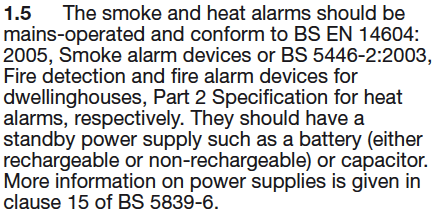


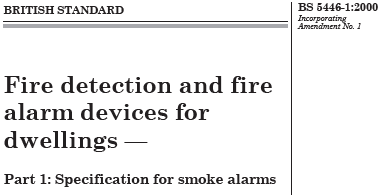





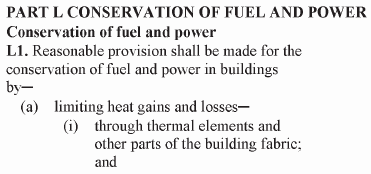
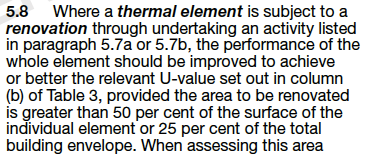



















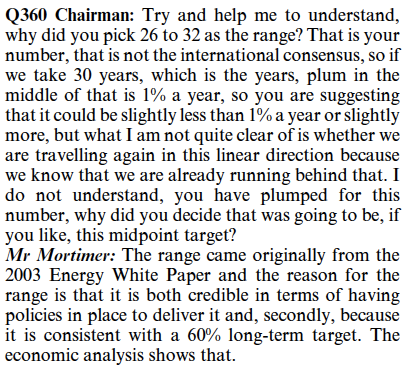





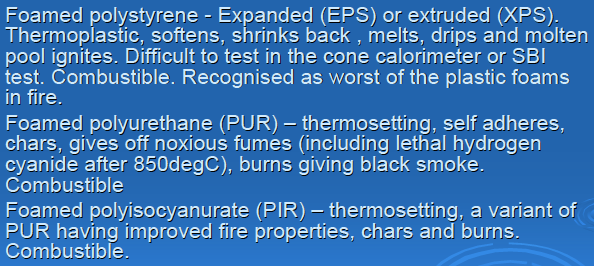

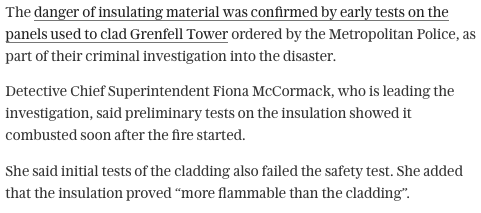
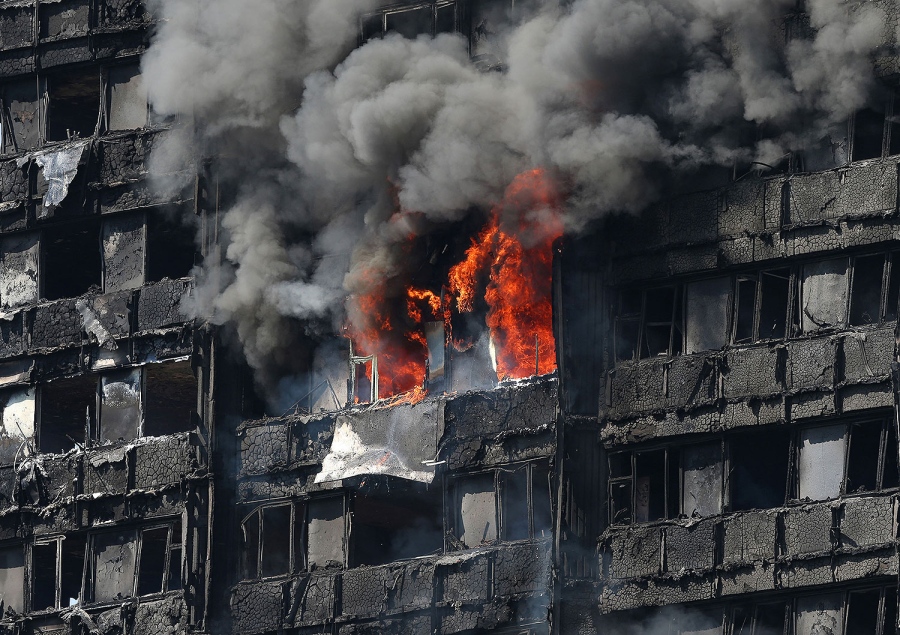






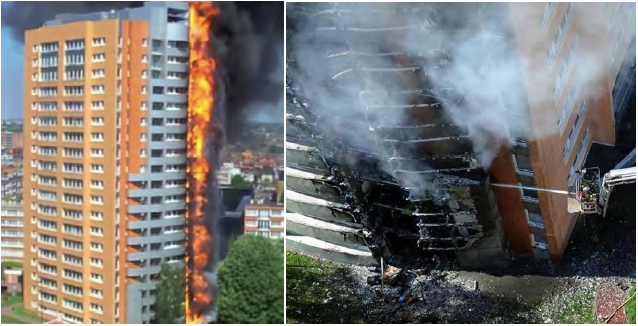
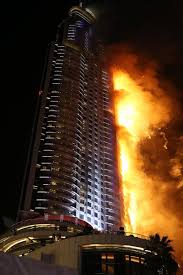

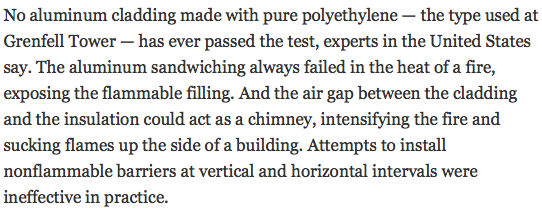
Andrew, firstly many thanks for doing so hugely detailed work on the technical aspects of the Grenfell fire, I’ve no doubt it will be of use to the upcoming investigations.
I entirely agree with you about the fact that EU regulations are in no way behind the cause of the fire, it was very much down to our own, as it turns out, rather ineffective and malleable building regulations.
Some interesting background on PIR insulation that you uncovered. The problem with PIR and PUR, is while they may char, and are less far less dense than the PE in the core of some ACM panels, it is still very much combustible in comparison to incombustible mineral or stone wool insulation, and releases huge quantities of Hydrogen Cyanide, Carbon Monoxide and Carbon Dioxide in a fire. This 2011 paper below from the University of Central Lancashire is very enlightening on this, it shows that only 8g of PIR insulation is required to make 1m3 of air lethally toxic for 50% of the population when burning in under ventilated conditions.
http://clok.uclan.ac.uk/1536/1/Stec and http://clok.uclan.ac.uk/1536/1/Stec%20and%20Hull_Fire_Toxicity_of_Insulation_Materials_EnergyBuildings_2011.pdf
John, thank you very much for the kind and encouraging words, and for your comment. I am glad you brought it up, since it was one of many pertinent points that I elected regretfully to omit, in the interests of brevity.
My thinking on it so far is that in a case like that of the tested Celotex RS5000 with non-combustible Marley Eternit cladding tiles – and supposing the classic BRE window breakout scenario – then if the insulation burns to some degree but the fire stays localised – then given that it is burning outside the building the risk to people inside the building – and given that this is presumably a very rare event – the risk from poisoning to inhabitants inside the building might be considered tolerable.
Or quite possibly it might not. But from the post-Grenfell mass fatality perspective, it seems relatively minor, while we make sure we don\’t have any more Grenfells. But then again, every life is precious and I think this is a very important factor to consider in longer term decisions about external cladding.
Andrew
Hi Andrew. I think the plastics insulation companies have touted this charring effect as a positive, when really to me it seems merely whitewash or pulling the wool over peoples eyes. The fact is it fails a combustion test at 750 deg c, and according to the UofCL tests combusted at 650 deg c, and released huge quantities of toxic fumes that would very quickly kill people. As many people would have had their windows open and were sleeping I am sure for some it was very quickly lethal. If they were awake and more subject to panic, the CO2 released would also cause more heavy breathing which would have quickened the intake of the Hydrogen Cyanide.
I think one important factor here is the cavity barriers or lack of. If you look at the uncovered insualtion at Grenfell during construction, you can see the black cavity barriers.
https://www.e-architect.co.uk/wp-content/uploads/2017/06/grenfell-tower-in-west-london-cladding-exposed-x230617.jpg
But to me these do not look like commercially available barriers- they look like fire stopping (non combustible) blocks with intumescent tape stuck, stapled and wrapped on or some worse kind of bodge. I doubt they were any use in stopping the flame extension through the cavity.
Thanks John. Remember that my initial purpose here was to assess claims like ‘the intensity of the fire … was attributable to the polyisocyanurate (PIR) insulation, rather than the cladding’.
I don’t have a problem with banning combustible insulation if that is what you are proposing. It’s just that I see a slight danger in aiming to high, as it were, and not achieving anything. Better to make sure that we don’t have another mass calamity first, I think.
As it happens I am inclined to think the best solution for high rise buildings might be to insist on limited combustibility and dispense with the large scale test route. There is nothing wrong with the latter in principle, but it seems to have a tendency to be downgraded to desktop studies supposedly based on real test data for supposedly similar systems. Then follows the natural tendency to backslide, as it were, and become sloppy, as the memory of the last disaster begins to fade.
The photograph from e-architect is good resolution, and better than the extracts I’ve seen from it on the internet. It shows a Cavity Barrier broken at the support rails, and therefore ineffective at the slab edge. It also shows no Cavity Barrier around the windows, and on the right a double layer of Phenolic insulation board. Polyisocyanurate would be a cream colour. I will repost it here. https://www.linkedin.com/pulse/bba-certificate-084510-missing-cavity-barriers-grenfell-ian-abley